-
Edible Birdhouse Gift Keeps On Giving
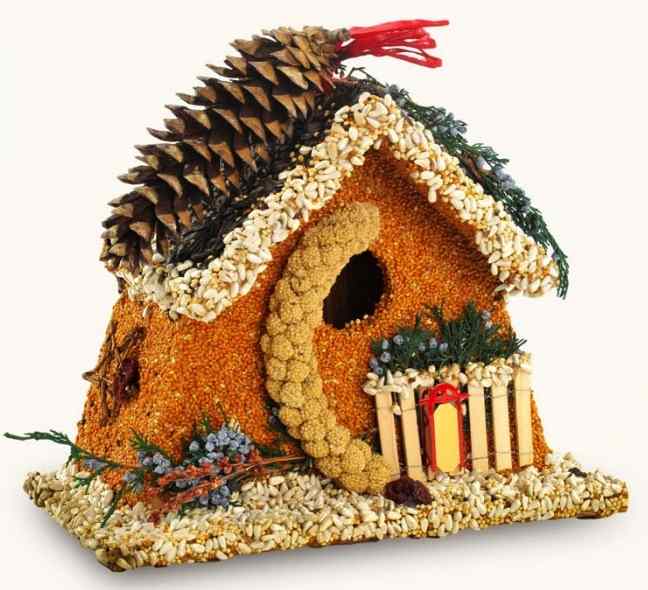 Kudos to the company who makes this edible birdhouse, because that’s all they do… specialty wild bird treats. And birds will tell you they do the job right! The Birdies Bed Breakfast not only looks good for an awesome present, it keeps on giving too.
Kudos to the company who makes this edible birdhouse, because that’s all they do… specialty wild bird treats. And birds will tell you they do the job right! The Birdies Bed Breakfast not only looks good for an awesome present, it keeps on giving too.Really like two gifts in one, a bird feeder at first, so the recipient gets an excuse to sit back, relax and enjoy watching some resident birds. It then becomes a real nesting site for spring. They may even catch someone roosting inside on a blustery day trying to escape the elements.
With 1.5-inch entry, it’s perfect for bluebirds, chickadees, warblers, wrens and other favored songbirds. The full size wooden house beneath the quality seed may be stained or painted, or even left natural to weather over time. A sturdy hook’s attached for easy hanging… just keep it away from squirrels!
Best to use edible birdhouses in sheltered areas as feeders, or with baffles or weather guards. They’ll feed more birds over a longer time if protected from harsh weather and pesky critters. Once the seed’s consumed, the house should be hung from a branch in a quiet part of the yard.
Keep watch in early spring (sure hope it’s earlier than last year) when local birds start claiming nest sites and attracting mates to raise their young. Now, what mama bird wouldn’t be totally impressed with digs like these?
-
Watch Out for this at Wild Bird Feeders
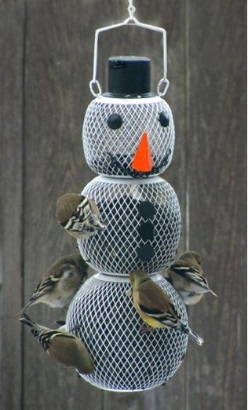 Seeing more traffic at your feeders lately? The recent cold snap and first freeze of the season has finches flocking to feeders. The frost will damage some plants with fruit or berries, and likely zap most flying insects. As the cold wears on, these natural food sources disappear so wild bird feeders start seeing increased activity.
Seeing more traffic at your feeders lately? The recent cold snap and first freeze of the season has finches flocking to feeders. The frost will damage some plants with fruit or berries, and likely zap most flying insects. As the cold wears on, these natural food sources disappear so wild bird feeders start seeing increased activity.Aside from the usual suspects like cardinals, chickadees titmice and wrens, goldfinches are still around from summer- but with their new winter feathers they’re looking a bit drab as seen on
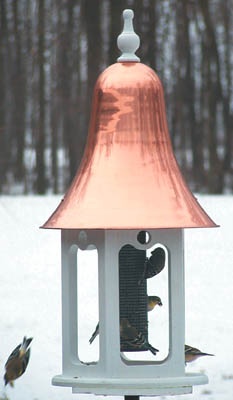 this snowman feeder. House Finches, who tend to travel in large flocks are crowding feeders now too, and they appear at new feeding areas in large groups. These birds are prone to a respiratory infection (see Cornell Lab for the history) that may infect other birds through bird feeders. The disease is actually conjunctivitis, though it’s not transferred to humans.
this snowman feeder. House Finches, who tend to travel in large flocks are crowding feeders now too, and they appear at new feeding areas in large groups. These birds are prone to a respiratory infection (see Cornell Lab for the history) that may infect other birds through bird feeders. The disease is actually conjunctivitis, though it’s not transferred to humans.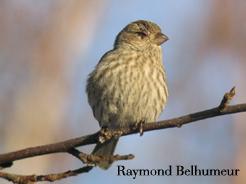 Affecting their eyes, the bacteria itself is not fatal, but infected birds usually end up blind and die from starvation or predation. You’ll see them with swollen, half-closed, or crusty eyes, and sometimes completely swollen shut. They go where it’s easy to feed, on the ground scavenging below feeders or staying in a nearby tree. It’s really a sad sight, but knowing that other birds may become infected through your feeders is worse.
Affecting their eyes, the bacteria itself is not fatal, but infected birds usually end up blind and die from starvation or predation. You’ll see them with swollen, half-closed, or crusty eyes, and sometimes completely swollen shut. They go where it’s easy to feed, on the ground scavenging below feeders or staying in a nearby tree. It’s really a sad sight, but knowing that other birds may become infected through your feeders is worse.This is why maintaining clean feeders is important. Non-porous surfaces like glass, copper, recycled plastic or vinyl are much easier to clean than wood. These wild bird feeders promote a healthier environment because bacteria can’t settle into cracks and crevices. There are a few easy steps to help prevent the spread of conjunctivitis and what to do should you see an infected bird in your yard.
- Space feeders as widely as possible to divert large crowds from gathering at one spot.
- Clean feeders with a 10% bleach solution (1 part bleach to 9 parts water) with extra attention to feeder ports. Rinse thoroughly and air dry.
- Rake fallen seed and bird droppings beneath feeders, keeping this area clean.
- Take feeders down if you see one or two birds with infected eyes, and clean as suggested above.
- Some folks even wait to hang feeders again, encouraging the flock to move on.
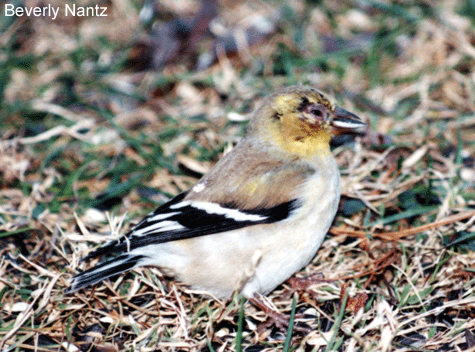
-
Seeing Red at Finch Feeders
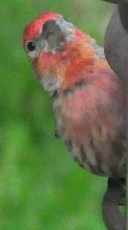 Think finch, and the first thing that usually comes to mind is a vibrant yellow American goldfinch, and because of their late breeding season, they’re out in full force this time of year. In fact, with their second molt, those bright feathers are giving way to new but drab winter plumage… so don’t think they’ve left! Finches are resident birds throughout most of the US. So keep on feeding them 🙂
Think finch, and the first thing that usually comes to mind is a vibrant yellow American goldfinch, and because of their late breeding season, they’re out in full force this time of year. In fact, with their second molt, those bright feathers are giving way to new but drab winter plumage… so don’t think they’ve left! Finches are resident birds throughout most of the US. So keep on feeding them 🙂The other finch is purple by name, but their plumage is really more red. You’re apt to see another red bird at finch feeders if you offer a premium seed mix.
 Cardinals adore their sunflower seed, and a better quality finch mix will have more of it.
Cardinals adore their sunflower seed, and a better quality finch mix will have more of it.Like anything else, there’s okay, better and best, this absolutely applies to birdseed too! Best will cost more, but it offers higher nutritional value and less waste in return. One of the reasons folks quit feeding birds is the ground mess (and who it attracts), so by using a mix with no fillers-which is what ends up on the ground anyway, you’ll not only attract more of the desired birds, you’ll have considerably less mess below feeders.
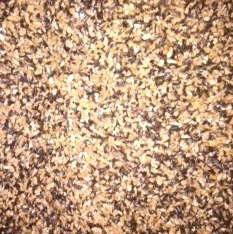 Try stocking your finch feeder with a mix of premium nyjer seed and sunflower chips. It’s got a high fat content, (great for winter) and there’s no corn, no milo, no millet that’s found in less expensive birdseed. No, we don’t sell it, but yes we use it, purchased from our local WBU… but don’t tell anyone!
Try stocking your finch feeder with a mix of premium nyjer seed and sunflower chips. It’s got a high fat content, (great for winter) and there’s no corn, no milo, no millet that’s found in less expensive birdseed. No, we don’t sell it, but yes we use it, purchased from our local WBU… but don’t tell anyone!Although cardinals do prefer larger, secure spaces while feeding, they’ll definitely perch at finch feeder with tray, or even hop on a perch itself. The new-fangled spiral feeders offer a bit of both! Birds run the spiral instead of feeding from individual perches, and they have optional seed trays too.
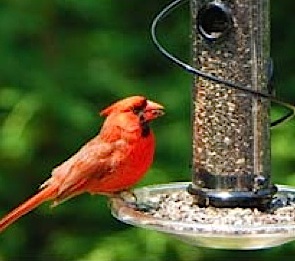
So don’t forget your finches once they’ve turned brown! Keep feeders fresh and consider a heated bath to help them through winter!
